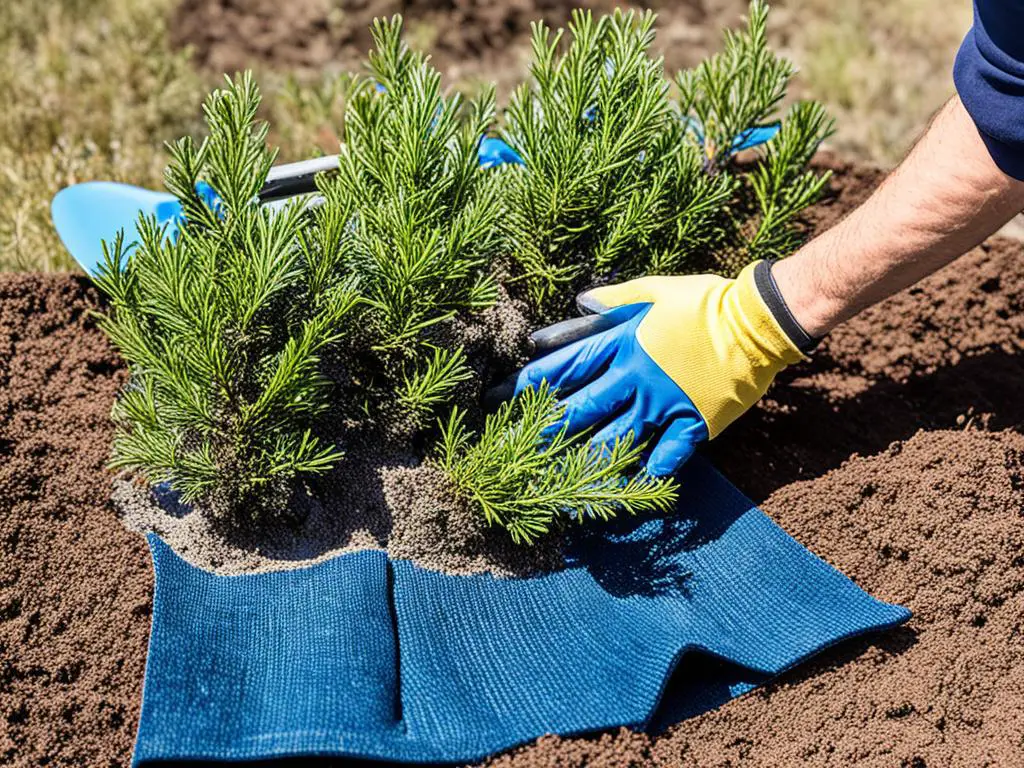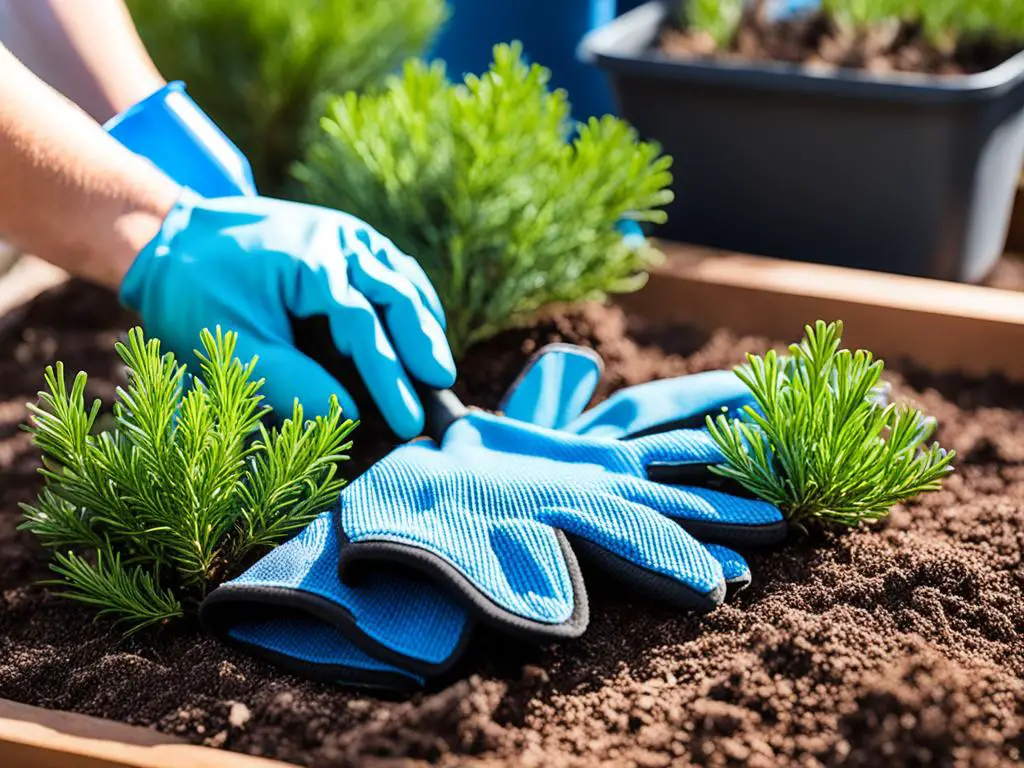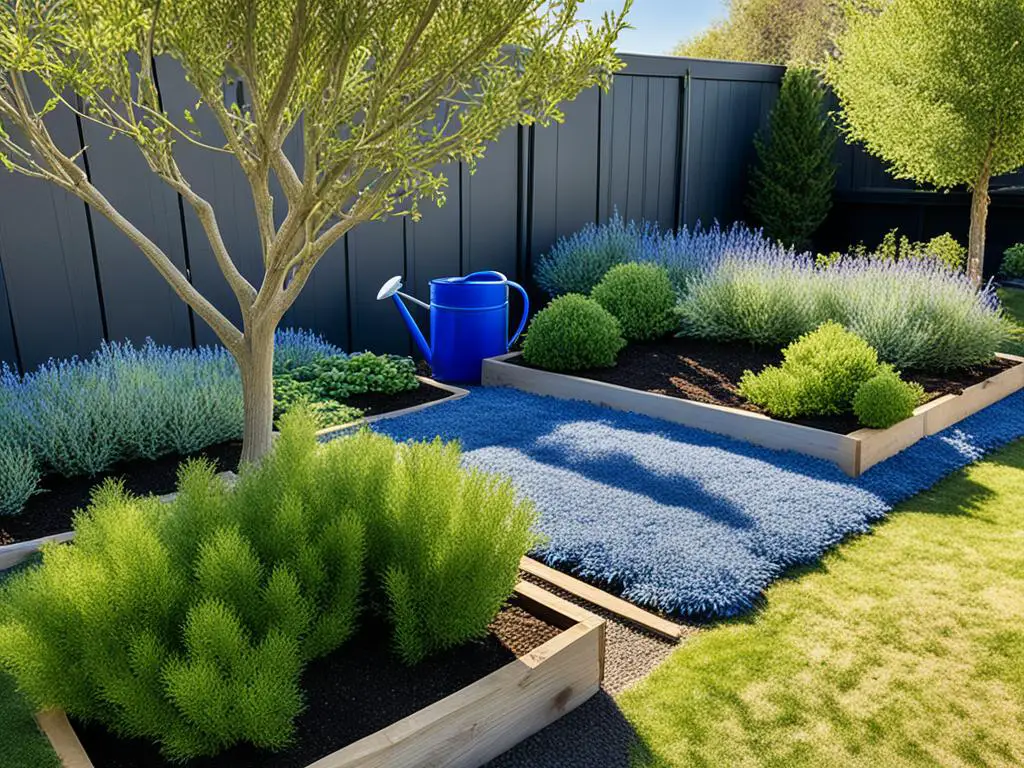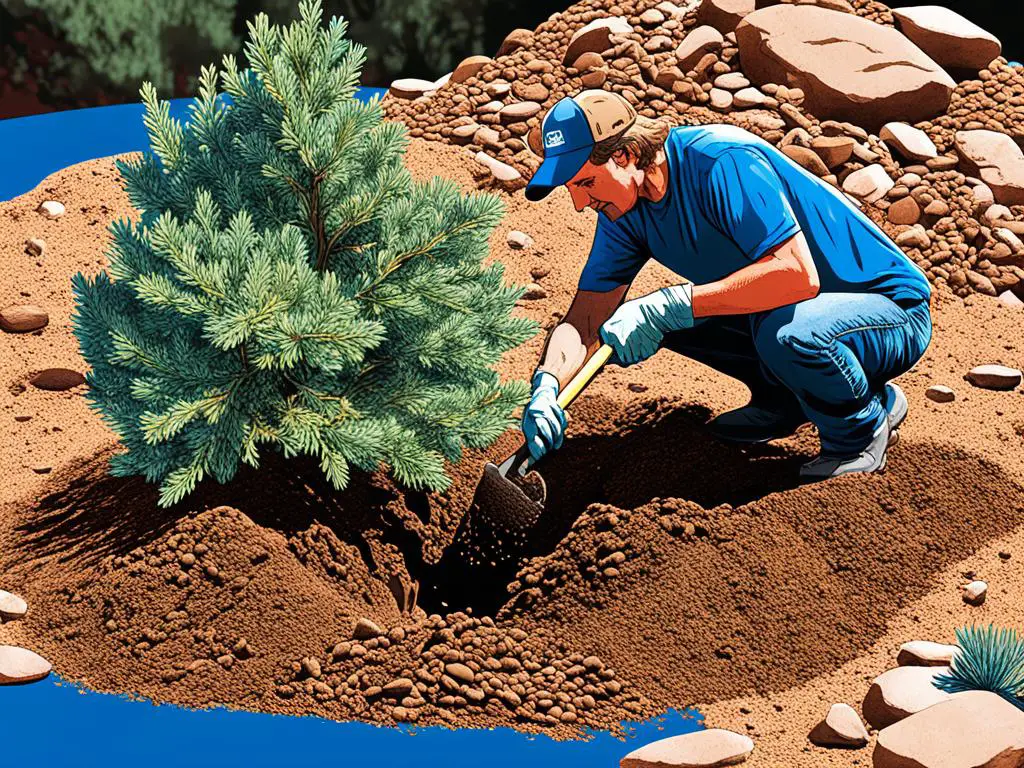Blue rug juniper (Juniperus horizontalis ‘Wiltonii’) is a beautiful and low-maintenance groundcover plant that can enhance the aesthetic appeal of any garden. With its silvery-blue foliage and unique spreading habit, it is not only visually stunning but also offers practical benefits such as erosion control and weed suppression. Whether you are a beginner or an experienced gardener, this step-by-step planting guide will provide you with all the essential information you need to successfully plant blue rug juniper in your garden.
Key Takeaways:
- Blue rug juniper is a low-maintenance groundcover plant with silvery-blue foliage.
- It thrives in sunny slopes with well-drained soil and prefers a pH range of 5.0 to 8.0.
- The best time to plant blue rug juniper is in the fall or early spring.
- Ensure your planting location receives full sun and the soil is prepared by removing weeds and improving drainage if necessary.
- Space the plants four to six feet apart to allow for proper spreading.
Blue Rug Juniper Planting Tips
When planting blue rug juniper, it’s important to follow these best practices and essential tips to ensure successful growth and establishment. Whether you’re a beginner or an experienced gardener, these guidelines will help you get started with planting blue rug juniper in your garden.
Planting Location
Blue rug juniper thrives in full sun exposure, although it can tolerate some shade. To achieve optimal growth, choose a location that receives at least six to eight hours of direct sunlight per day. This will help the plant develop its vibrant silvery-blue foliage.
Soil Conditions
The soil should be well-drained and preferably sandy, with a pH range of 5.0 to 8.0. Before planting, prepare the soil by removing weeds and improving drainage if necessary. Blue rug juniper doesn’t tolerate wet, waterlogged soil, so ensure proper water drainage to prevent root rot.
Spacing and Planting
Space the blue rug juniper plants four to six feet apart to allow for sufficient spreading and the formation of a thick mat. This spacing promotes healthy growth and prevents overcrowding, ensuring each plant receives enough sunlight and nutrients.
Watering
Water the plants regularly until they are established, usually during the first one to two years. This helps the roots establish themselves in the soil. Once established, blue rug juniper is drought-tolerant and only requires supplemental watering during extended dry spells or droughts.
Pruning
While blue rug juniper doesn’t require regular pruning, light pruning can encourage fuller growth and maintain its overall shape. If necessary, trim any unwanted or overgrown branches. However, be cautious not to prune excessively, as blue rug juniper tends to have a compact, spreading growth habit.
Propagation
Propagation of blue rug juniper can be done through stem cuttings. However, it’s important to note that seeds are not recommended for this particular cultivar. Taking stem cuttings from healthy, established plants is the most reliable method for propagating blue rug juniper.
By following these planting tips and best practices, you’ll be well on your way to successfully growing blue rug juniper in your garden. Next, we’ll explore the essential care and maintenance requirements for blue rug juniper to ensure its long-term health and vitality.

Blue Rug Juniper Care and Maintenance
Blue rug juniper is a low-maintenance plant that requires minimal care. Once established, it is drought-tolerant and does not require frequent watering. However, it is important to ensure that the soil is well-drained and not overly wet, as this can cause root rot. Blue rug juniper is resistant to pests and diseases, but it’s best to provide adequate airflow and drainage to prevent issues. Pruning is not necessary unless the plant becomes unruly or damaged, but light pruning can promote fuller growth. Fertilizer is generally not needed, but an organic fertilizer can be applied in the fall for mature plants. It is important to remove garden debris and trash from the plant’s dense groundcover to maintain its appearance.
Tips for Blue Rug Juniper Care:
- Ensure well-drained soil:
- Provide adequate airflow and drainage:
- Prune if necessary:
- Apply organic fertilizer in the fall:
- Maintain cleanliness:
Blue rug juniper is a resilient plant that requires minimal attention, making it an excellent choice for those with busy lifestyles or limited gardening experience. Its adaptability and low-maintenance nature make it a valuable addition to any landscape. With just a little care and attention, blue rug juniper will reward you with its beautiful silvery-blue foliage and dense groundcover.
To visually illustrate the care and maintenance requirements of blue rug juniper, refer to the table below:
| Care and Maintenance | Description |
|---|---|
| Watering | Once established, water sparingly. Only provide supplemental watering during extended dry spells or drought. |
| Soil | Ensure well-drained soil with a pH range of 5.0 to 8.0. |
| Pests and Diseases | Blue rug juniper is resistant to pests and diseases. However, proper airflow and drainage are essential for prevention. |
| Pruning | Pruning is not necessary unless the plant becomes unruly or damaged. Light pruning can promote fuller growth. |
| Fertilizer | Fertilizer is generally not needed. However, an organic fertilizer can be applied in the fall for mature plants. |
| Cleanliness | Remove garden debris and trash from the plant’s dense groundcover to maintain its appearance. |

With proper care and maintenance, your blue rug juniper will thrive and provide a beautiful and low-maintenance addition to your garden. By following these simple guidelines, you can enjoy the beauty and benefits of this resilient plant for years to come.
Ideal Growing Conditions for Blue Rug Juniper
Blue rug juniper (Juniperus horizontalis ‘Wiltonii’) is a versatile and resilient groundcover plant that can thrive in various conditions. To ensure optimal growth and health for your blue rug juniper, it is important to provide the ideal growing environment.
Sunlight Requirements
Blue rug juniper thrives in full sun, requiring at least six to eight hours of direct sunlight per day. While it can tolerate some shade, excessive shade may result in sparse foliage and reduced growth. Therefore, it is best to choose a location with ample sunlight to maximize the plant’s potential.
Soil Type and pH Level
The plant prefers well-drained soil, particularly sandy soil that allows for proper water drainage. However, blue rug juniper is adaptable and can grow in a variety of soil types, including rocky soil. It can even tolerate salt from saltwater spray or road salt. A pH range of 5.0 to 8.0 is considered optimal for blue rug juniper’s growth and development.
Temperature Tolerance
Blue rug juniper is known for its resilience in extreme climates. It can withstand a wide range of temperatures, including cold winters down to USDA hardiness zone 3. This makes it suitable for a variety of regions and climates, where other plants may struggle to survive.
Planting Timing
The timing of planting blue rug juniper is essential for its successful establishment. It is recommended to plant blue rug juniper in the fall or early spring when the temperature consistently remains below 60 degrees Fahrenheit. This ensures that the plant can acclimate to its new environment and establish strong roots before facing harsher weather conditions.

Creating the ideal growing conditions for blue rug juniper will contribute to its overall health, vigor, and longevity. By providing sufficient sunlight, well-drained soil, and planting at the right time, you can ensure that your blue rug juniper thrives and enhances the beauty of your garden.
| Requirements | Ideal Conditions |
|---|---|
| Sunlight | At least 6-8 hours of direct sunlight per day |
| Soil | Well-drained, sandy soil with a pH range of 5.0-8.0 |
| Temperature Tolerance | Tolerates a wide range of temperatures, suitable for USDA hardiness zone 3 |
| Planting Timing | Best planted in fall or early spring when temperature consistently below 60°F |
Conclusion
Blue rug juniper (Juniperus horizontalis ‘Wiltonii’) is a versatile and low-maintenance groundcover plant that can enhance the beauty and functionality of your garden. Its striking silvery-blue foliage and dense spreading habit make it an ideal choice for sunny slopes, retaining walls, and rock gardens. By following the proper planting and care instructions, you can ensure healthy growth and ample ground coverage of blue rug juniper.
To achieve optimal results, select a sunny location with well-drained soil and provide adequate watering during the establishment phase. Proper spacing between plants promotes the formation of a dense mat, while occasional shaping and pruning helps maintain its desired appearance. With its natural resilience against pests and diseases, blue rug juniper is perfect for those seeking a low-maintenance landscaping solution.
In summary, blue rug juniper is a reliable and visually appealing groundcover plant that requires minimal effort to thrive. Its adaptability to various growing conditions and its ability to withstand challenging climates make it an excellent choice for both experienced gardeners and beginners. With its vibrant foliage and robust growth, blue rug juniper can transform your outdoor space into a stunning and effortlessly maintained landscape. Consider adding blue rug juniper to your garden today and enjoy its beauty for years to come.




